Abstract Art and Expression of Thoughts
VerifiedAdded on 2023/01/19
|11
|2421
|35
AI Summary
This paper analyzes the genre of abstract art and its use in expressing thoughts and experiences. It focuses on the works of Kandinsky.
Contribute Materials
Your contribution can guide someone’s learning journey. Share your
documents today.
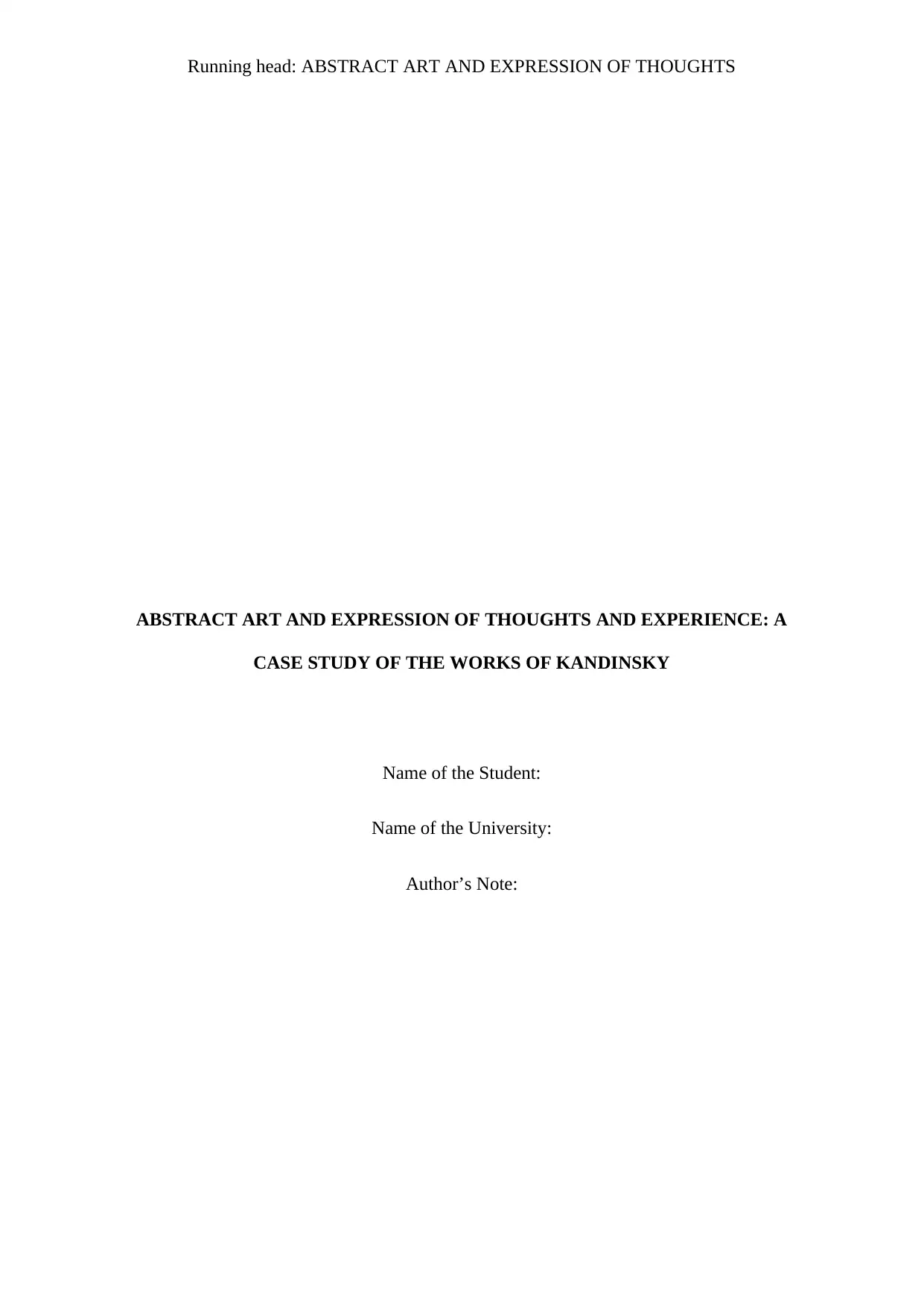
Running head: ABSTRACT ART AND EXPRESSION OF THOUGHTS
ABSTRACT ART AND EXPRESSION OF THOUGHTS AND EXPERIENCE: A
CASE STUDY OF THE WORKS OF KANDINSKY
Name of the Student:
Name of the University:
Author’s Note:
ABSTRACT ART AND EXPRESSION OF THOUGHTS AND EXPERIENCE: A
CASE STUDY OF THE WORKS OF KANDINSKY
Name of the Student:
Name of the University:
Author’s Note:
Secure Best Marks with AI Grader
Need help grading? Try our AI Grader for instant feedback on your assignments.
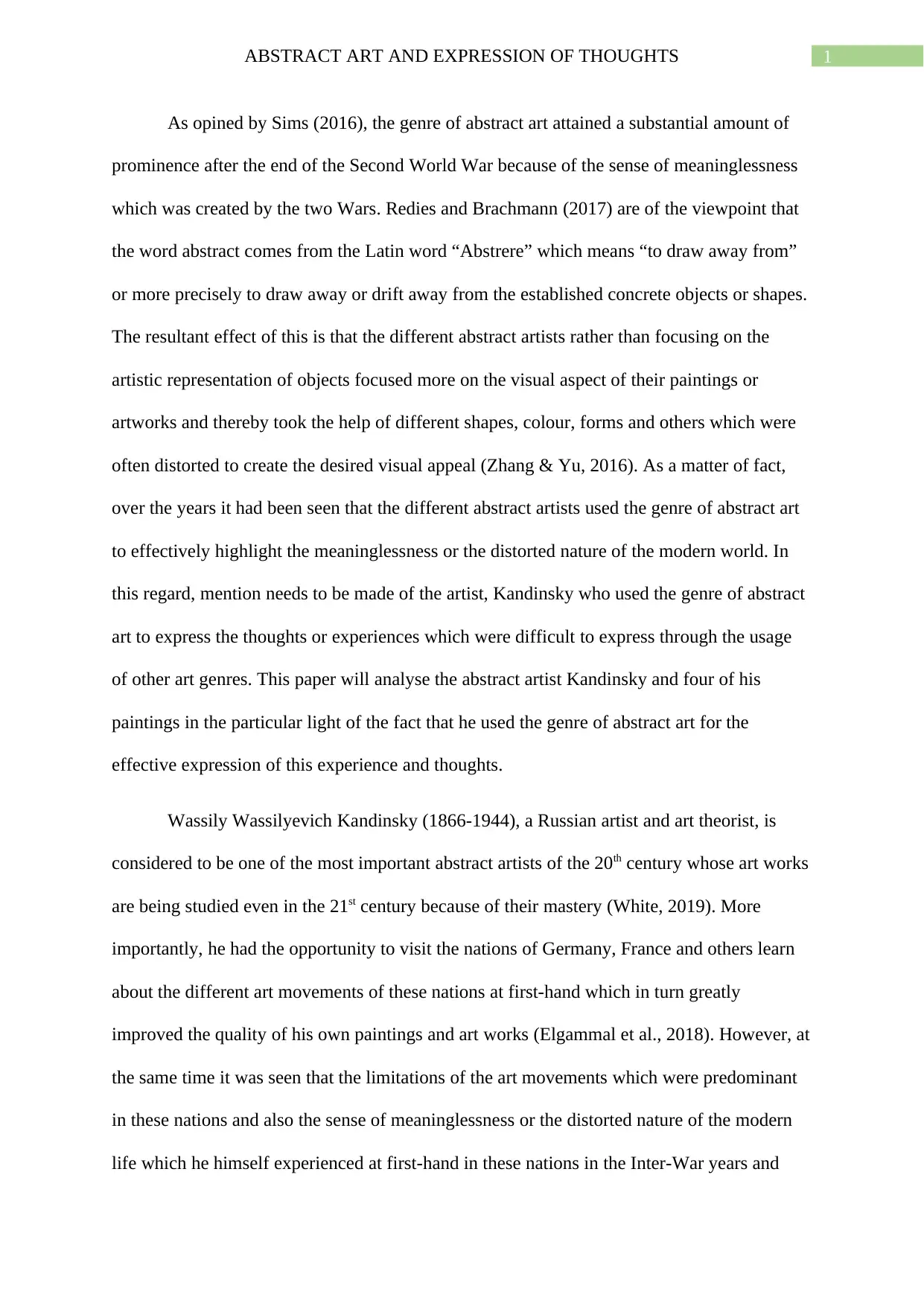
1ABSTRACT ART AND EXPRESSION OF THOUGHTS
As opined by Sims (2016), the genre of abstract art attained a substantial amount of
prominence after the end of the Second World War because of the sense of meaninglessness
which was created by the two Wars. Redies and Brachmann (2017) are of the viewpoint that
the word abstract comes from the Latin word “Abstrere” which means “to draw away from”
or more precisely to draw away or drift away from the established concrete objects or shapes.
The resultant effect of this is that the different abstract artists rather than focusing on the
artistic representation of objects focused more on the visual aspect of their paintings or
artworks and thereby took the help of different shapes, colour, forms and others which were
often distorted to create the desired visual appeal (Zhang & Yu, 2016). As a matter of fact,
over the years it had been seen that the different abstract artists used the genre of abstract art
to effectively highlight the meaninglessness or the distorted nature of the modern world. In
this regard, mention needs to be made of the artist, Kandinsky who used the genre of abstract
art to express the thoughts or experiences which were difficult to express through the usage
of other art genres. This paper will analyse the abstract artist Kandinsky and four of his
paintings in the particular light of the fact that he used the genre of abstract art for the
effective expression of this experience and thoughts.
Wassily Wassilyevich Kandinsky (1866-1944), a Russian artist and art theorist, is
considered to be one of the most important abstract artists of the 20th century whose art works
are being studied even in the 21st century because of their mastery (White, 2019). More
importantly, he had the opportunity to visit the nations of Germany, France and others learn
about the different art movements of these nations at first-hand which in turn greatly
improved the quality of his own paintings and art works (Elgammal et al., 2018). However, at
the same time it was seen that the limitations of the art movements which were predominant
in these nations and also the sense of meaninglessness or the distorted nature of the modern
life which he himself experienced at first-hand in these nations in the Inter-War years and
As opined by Sims (2016), the genre of abstract art attained a substantial amount of
prominence after the end of the Second World War because of the sense of meaninglessness
which was created by the two Wars. Redies and Brachmann (2017) are of the viewpoint that
the word abstract comes from the Latin word “Abstrere” which means “to draw away from”
or more precisely to draw away or drift away from the established concrete objects or shapes.
The resultant effect of this is that the different abstract artists rather than focusing on the
artistic representation of objects focused more on the visual aspect of their paintings or
artworks and thereby took the help of different shapes, colour, forms and others which were
often distorted to create the desired visual appeal (Zhang & Yu, 2016). As a matter of fact,
over the years it had been seen that the different abstract artists used the genre of abstract art
to effectively highlight the meaninglessness or the distorted nature of the modern world. In
this regard, mention needs to be made of the artist, Kandinsky who used the genre of abstract
art to express the thoughts or experiences which were difficult to express through the usage
of other art genres. This paper will analyse the abstract artist Kandinsky and four of his
paintings in the particular light of the fact that he used the genre of abstract art for the
effective expression of this experience and thoughts.
Wassily Wassilyevich Kandinsky (1866-1944), a Russian artist and art theorist, is
considered to be one of the most important abstract artists of the 20th century whose art works
are being studied even in the 21st century because of their mastery (White, 2019). More
importantly, he had the opportunity to visit the nations of Germany, France and others learn
about the different art movements of these nations at first-hand which in turn greatly
improved the quality of his own paintings and art works (Elgammal et al., 2018). However, at
the same time it was seen that the limitations of the art movements which were predominant
in these nations and also the sense of meaninglessness or the distorted nature of the modern
life which he himself experienced at first-hand in these nations in the Inter-War years and
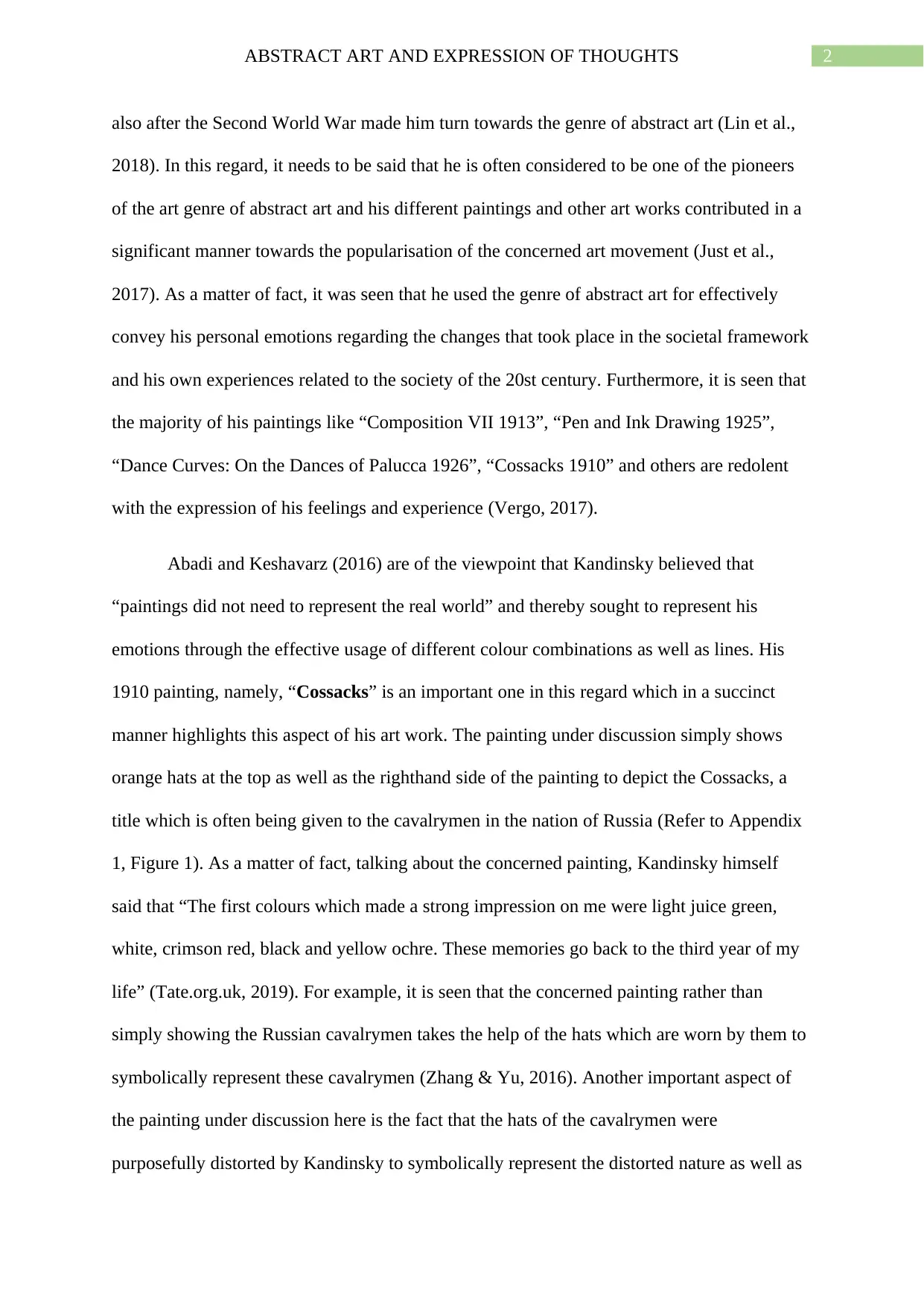
2ABSTRACT ART AND EXPRESSION OF THOUGHTS
also after the Second World War made him turn towards the genre of abstract art (Lin et al.,
2018). In this regard, it needs to be said that he is often considered to be one of the pioneers
of the art genre of abstract art and his different paintings and other art works contributed in a
significant manner towards the popularisation of the concerned art movement (Just et al.,
2017). As a matter of fact, it was seen that he used the genre of abstract art for effectively
convey his personal emotions regarding the changes that took place in the societal framework
and his own experiences related to the society of the 20st century. Furthermore, it is seen that
the majority of his paintings like “Composition VII 1913”, “Pen and Ink Drawing 1925”,
“Dance Curves: On the Dances of Palucca 1926”, “Cossacks 1910” and others are redolent
with the expression of his feelings and experience (Vergo, 2017).
Abadi and Keshavarz (2016) are of the viewpoint that Kandinsky believed that
“paintings did not need to represent the real world” and thereby sought to represent his
emotions through the effective usage of different colour combinations as well as lines. His
1910 painting, namely, “Cossacks” is an important one in this regard which in a succinct
manner highlights this aspect of his art work. The painting under discussion simply shows
orange hats at the top as well as the righthand side of the painting to depict the Cossacks, a
title which is often being given to the cavalrymen in the nation of Russia (Refer to Appendix
1, Figure 1). As a matter of fact, talking about the concerned painting, Kandinsky himself
said that “The first colours which made a strong impression on me were light juice green,
white, crimson red, black and yellow ochre. These memories go back to the third year of my
life” (Tate.org.uk, 2019). For example, it is seen that the concerned painting rather than
simply showing the Russian cavalrymen takes the help of the hats which are worn by them to
symbolically represent these cavalrymen (Zhang & Yu, 2016). Another important aspect of
the painting under discussion here is the fact that the hats of the cavalrymen were
purposefully distorted by Kandinsky to symbolically represent the distorted nature as well as
also after the Second World War made him turn towards the genre of abstract art (Lin et al.,
2018). In this regard, it needs to be said that he is often considered to be one of the pioneers
of the art genre of abstract art and his different paintings and other art works contributed in a
significant manner towards the popularisation of the concerned art movement (Just et al.,
2017). As a matter of fact, it was seen that he used the genre of abstract art for effectively
convey his personal emotions regarding the changes that took place in the societal framework
and his own experiences related to the society of the 20st century. Furthermore, it is seen that
the majority of his paintings like “Composition VII 1913”, “Pen and Ink Drawing 1925”,
“Dance Curves: On the Dances of Palucca 1926”, “Cossacks 1910” and others are redolent
with the expression of his feelings and experience (Vergo, 2017).
Abadi and Keshavarz (2016) are of the viewpoint that Kandinsky believed that
“paintings did not need to represent the real world” and thereby sought to represent his
emotions through the effective usage of different colour combinations as well as lines. His
1910 painting, namely, “Cossacks” is an important one in this regard which in a succinct
manner highlights this aspect of his art work. The painting under discussion simply shows
orange hats at the top as well as the righthand side of the painting to depict the Cossacks, a
title which is often being given to the cavalrymen in the nation of Russia (Refer to Appendix
1, Figure 1). As a matter of fact, talking about the concerned painting, Kandinsky himself
said that “The first colours which made a strong impression on me were light juice green,
white, crimson red, black and yellow ochre. These memories go back to the third year of my
life” (Tate.org.uk, 2019). For example, it is seen that the concerned painting rather than
simply showing the Russian cavalrymen takes the help of the hats which are worn by them to
symbolically represent these cavalrymen (Zhang & Yu, 2016). Another important aspect of
the painting under discussion here is the fact that the hats of the cavalrymen were
purposefully distorted by Kandinsky to symbolically represent the distorted nature as well as
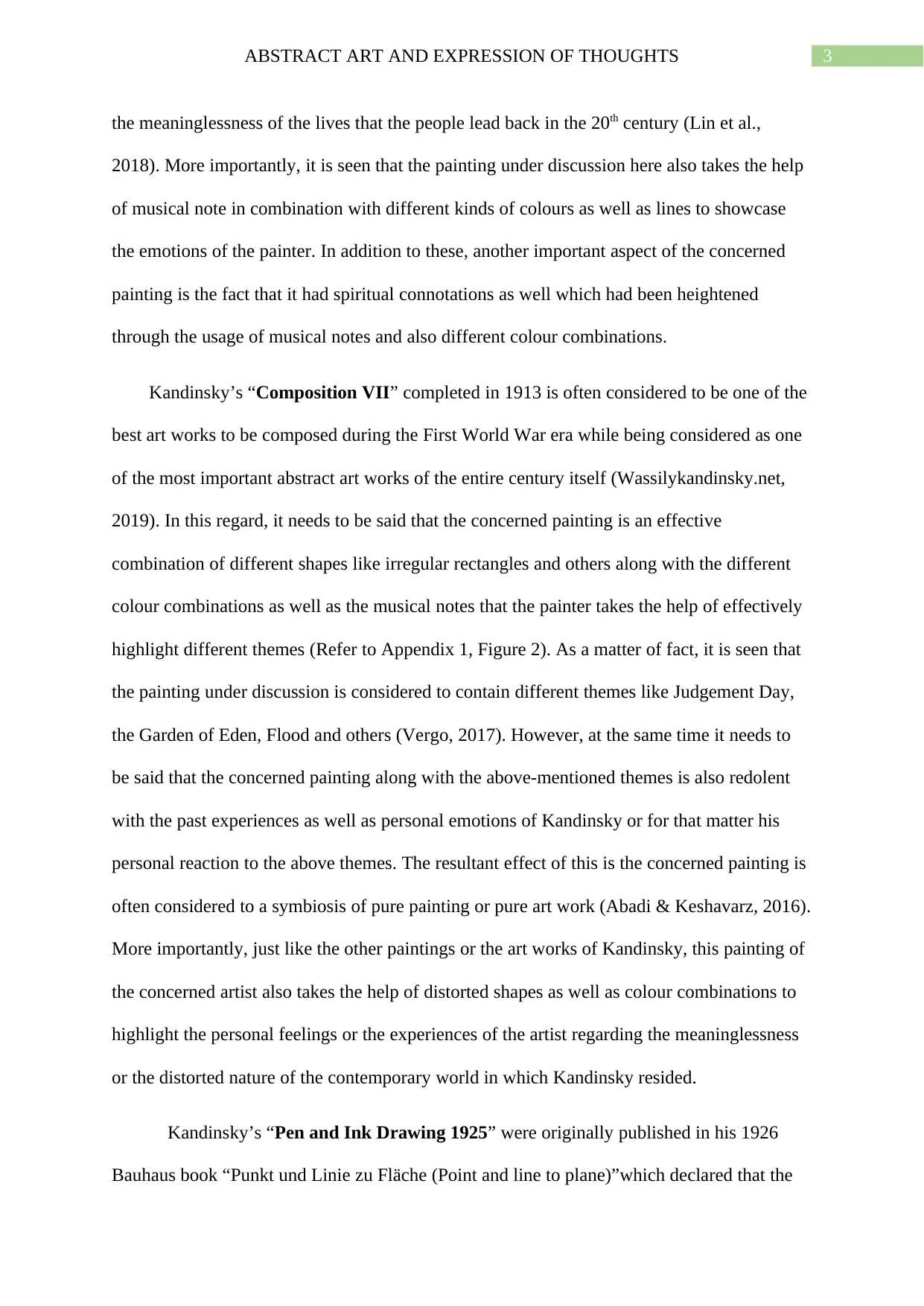
3ABSTRACT ART AND EXPRESSION OF THOUGHTS
the meaninglessness of the lives that the people lead back in the 20th century (Lin et al.,
2018). More importantly, it is seen that the painting under discussion here also takes the help
of musical note in combination with different kinds of colours as well as lines to showcase
the emotions of the painter. In addition to these, another important aspect of the concerned
painting is the fact that it had spiritual connotations as well which had been heightened
through the usage of musical notes and also different colour combinations.
Kandinsky’s “Composition VII” completed in 1913 is often considered to be one of the
best art works to be composed during the First World War era while being considered as one
of the most important abstract art works of the entire century itself (Wassilykandinsky.net,
2019). In this regard, it needs to be said that the concerned painting is an effective
combination of different shapes like irregular rectangles and others along with the different
colour combinations as well as the musical notes that the painter takes the help of effectively
highlight different themes (Refer to Appendix 1, Figure 2). As a matter of fact, it is seen that
the painting under discussion is considered to contain different themes like Judgement Day,
the Garden of Eden, Flood and others (Vergo, 2017). However, at the same time it needs to
be said that the concerned painting along with the above-mentioned themes is also redolent
with the past experiences as well as personal emotions of Kandinsky or for that matter his
personal reaction to the above themes. The resultant effect of this is the concerned painting is
often considered to a symbiosis of pure painting or pure art work (Abadi & Keshavarz, 2016).
More importantly, just like the other paintings or the art works of Kandinsky, this painting of
the concerned artist also takes the help of distorted shapes as well as colour combinations to
highlight the personal feelings or the experiences of the artist regarding the meaninglessness
or the distorted nature of the contemporary world in which Kandinsky resided.
Kandinsky’s “Pen and Ink Drawing 1925” were originally published in his 1926
Bauhaus book “Punkt und Linie zu Fläche (Point and line to plane)”which declared that the
the meaninglessness of the lives that the people lead back in the 20th century (Lin et al.,
2018). More importantly, it is seen that the painting under discussion here also takes the help
of musical note in combination with different kinds of colours as well as lines to showcase
the emotions of the painter. In addition to these, another important aspect of the concerned
painting is the fact that it had spiritual connotations as well which had been heightened
through the usage of musical notes and also different colour combinations.
Kandinsky’s “Composition VII” completed in 1913 is often considered to be one of the
best art works to be composed during the First World War era while being considered as one
of the most important abstract art works of the entire century itself (Wassilykandinsky.net,
2019). In this regard, it needs to be said that the concerned painting is an effective
combination of different shapes like irregular rectangles and others along with the different
colour combinations as well as the musical notes that the painter takes the help of effectively
highlight different themes (Refer to Appendix 1, Figure 2). As a matter of fact, it is seen that
the painting under discussion is considered to contain different themes like Judgement Day,
the Garden of Eden, Flood and others (Vergo, 2017). However, at the same time it needs to
be said that the concerned painting along with the above-mentioned themes is also redolent
with the past experiences as well as personal emotions of Kandinsky or for that matter his
personal reaction to the above themes. The resultant effect of this is the concerned painting is
often considered to a symbiosis of pure painting or pure art work (Abadi & Keshavarz, 2016).
More importantly, just like the other paintings or the art works of Kandinsky, this painting of
the concerned artist also takes the help of distorted shapes as well as colour combinations to
highlight the personal feelings or the experiences of the artist regarding the meaninglessness
or the distorted nature of the contemporary world in which Kandinsky resided.
Kandinsky’s “Pen and Ink Drawing 1925” were originally published in his 1926
Bauhaus book “Punkt und Linie zu Fläche (Point and line to plane)”which declared that the
Secure Best Marks with AI Grader
Need help grading? Try our AI Grader for instant feedback on your assignments.
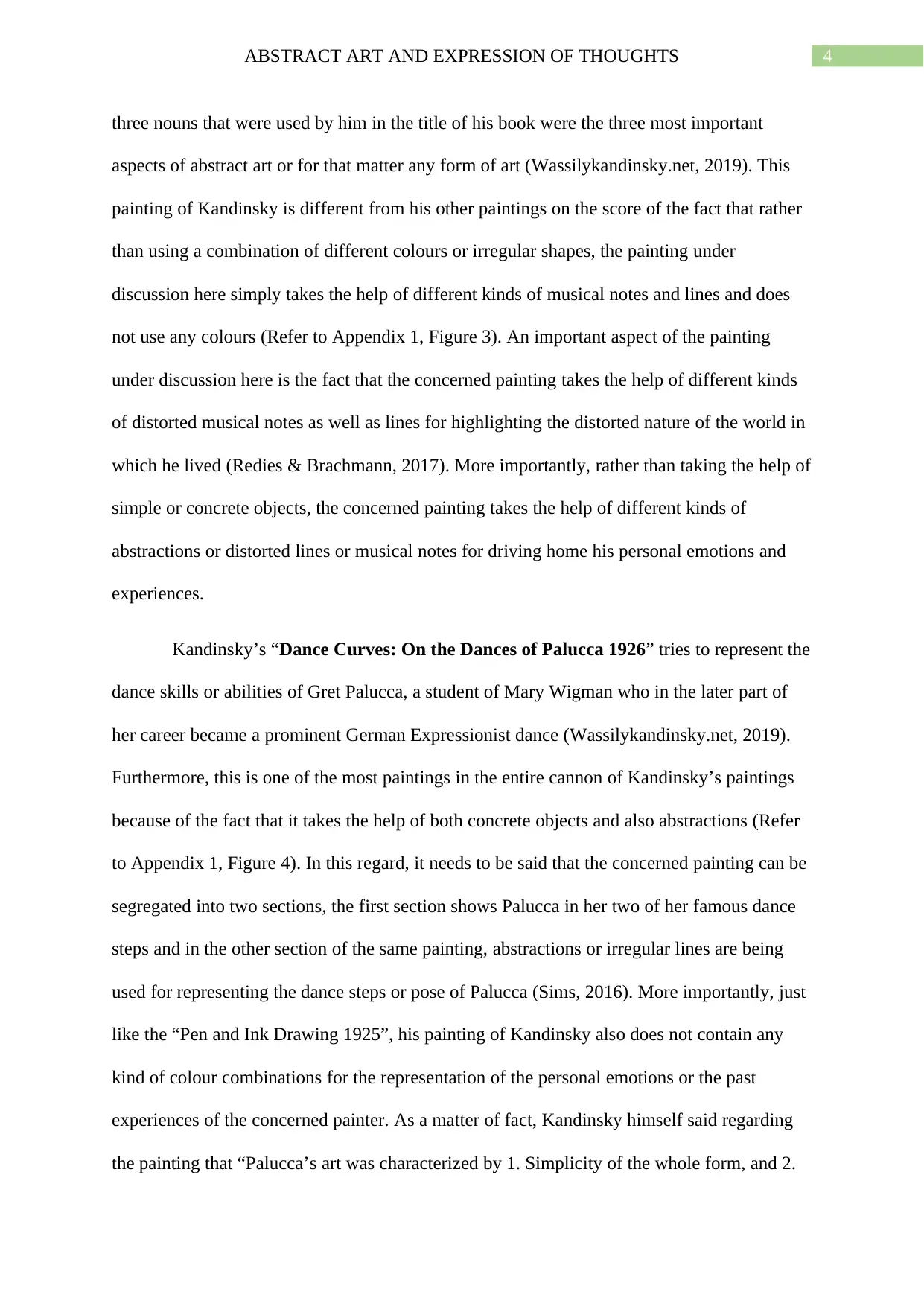
4ABSTRACT ART AND EXPRESSION OF THOUGHTS
three nouns that were used by him in the title of his book were the three most important
aspects of abstract art or for that matter any form of art (Wassilykandinsky.net, 2019). This
painting of Kandinsky is different from his other paintings on the score of the fact that rather
than using a combination of different colours or irregular shapes, the painting under
discussion here simply takes the help of different kinds of musical notes and lines and does
not use any colours (Refer to Appendix 1, Figure 3). An important aspect of the painting
under discussion here is the fact that the concerned painting takes the help of different kinds
of distorted musical notes as well as lines for highlighting the distorted nature of the world in
which he lived (Redies & Brachmann, 2017). More importantly, rather than taking the help of
simple or concrete objects, the concerned painting takes the help of different kinds of
abstractions or distorted lines or musical notes for driving home his personal emotions and
experiences.
Kandinsky’s “Dance Curves: On the Dances of Palucca 1926” tries to represent the
dance skills or abilities of Gret Palucca, a student of Mary Wigman who in the later part of
her career became a prominent German Expressionist dance (Wassilykandinsky.net, 2019).
Furthermore, this is one of the most paintings in the entire cannon of Kandinsky’s paintings
because of the fact that it takes the help of both concrete objects and also abstractions (Refer
to Appendix 1, Figure 4). In this regard, it needs to be said that the concerned painting can be
segregated into two sections, the first section shows Palucca in her two of her famous dance
steps and in the other section of the same painting, abstractions or irregular lines are being
used for representing the dance steps or pose of Palucca (Sims, 2016). More importantly, just
like the “Pen and Ink Drawing 1925”, his painting of Kandinsky also does not contain any
kind of colour combinations for the representation of the personal emotions or the past
experiences of the concerned painter. As a matter of fact, Kandinsky himself said regarding
the painting that “Palucca’s art was characterized by 1. Simplicity of the whole form, and 2.
three nouns that were used by him in the title of his book were the three most important
aspects of abstract art or for that matter any form of art (Wassilykandinsky.net, 2019). This
painting of Kandinsky is different from his other paintings on the score of the fact that rather
than using a combination of different colours or irregular shapes, the painting under
discussion here simply takes the help of different kinds of musical notes and lines and does
not use any colours (Refer to Appendix 1, Figure 3). An important aspect of the painting
under discussion here is the fact that the concerned painting takes the help of different kinds
of distorted musical notes as well as lines for highlighting the distorted nature of the world in
which he lived (Redies & Brachmann, 2017). More importantly, rather than taking the help of
simple or concrete objects, the concerned painting takes the help of different kinds of
abstractions or distorted lines or musical notes for driving home his personal emotions and
experiences.
Kandinsky’s “Dance Curves: On the Dances of Palucca 1926” tries to represent the
dance skills or abilities of Gret Palucca, a student of Mary Wigman who in the later part of
her career became a prominent German Expressionist dance (Wassilykandinsky.net, 2019).
Furthermore, this is one of the most paintings in the entire cannon of Kandinsky’s paintings
because of the fact that it takes the help of both concrete objects and also abstractions (Refer
to Appendix 1, Figure 4). In this regard, it needs to be said that the concerned painting can be
segregated into two sections, the first section shows Palucca in her two of her famous dance
steps and in the other section of the same painting, abstractions or irregular lines are being
used for representing the dance steps or pose of Palucca (Sims, 2016). More importantly, just
like the “Pen and Ink Drawing 1925”, his painting of Kandinsky also does not contain any
kind of colour combinations for the representation of the personal emotions or the past
experiences of the concerned painter. As a matter of fact, Kandinsky himself said regarding
the painting that “Palucca’s art was characterized by 1. Simplicity of the whole form, and 2.
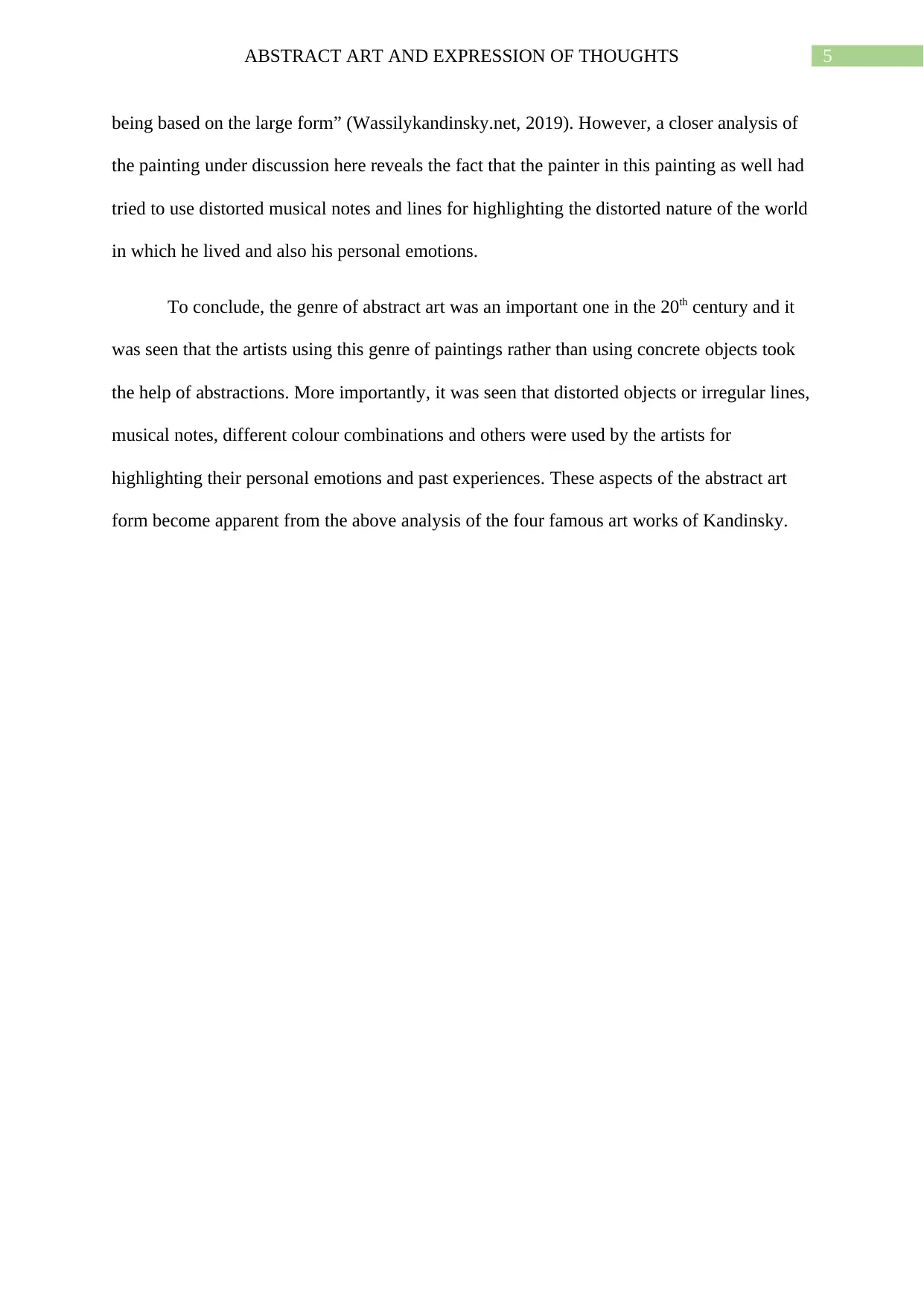
5ABSTRACT ART AND EXPRESSION OF THOUGHTS
being based on the large form” (Wassilykandinsky.net, 2019). However, a closer analysis of
the painting under discussion here reveals the fact that the painter in this painting as well had
tried to use distorted musical notes and lines for highlighting the distorted nature of the world
in which he lived and also his personal emotions.
To conclude, the genre of abstract art was an important one in the 20th century and it
was seen that the artists using this genre of paintings rather than using concrete objects took
the help of abstractions. More importantly, it was seen that distorted objects or irregular lines,
musical notes, different colour combinations and others were used by the artists for
highlighting their personal emotions and past experiences. These aspects of the abstract art
form become apparent from the above analysis of the four famous art works of Kandinsky.
being based on the large form” (Wassilykandinsky.net, 2019). However, a closer analysis of
the painting under discussion here reveals the fact that the painter in this painting as well had
tried to use distorted musical notes and lines for highlighting the distorted nature of the world
in which he lived and also his personal emotions.
To conclude, the genre of abstract art was an important one in the 20th century and it
was seen that the artists using this genre of paintings rather than using concrete objects took
the help of abstractions. More importantly, it was seen that distorted objects or irregular lines,
musical notes, different colour combinations and others were used by the artists for
highlighting their personal emotions and past experiences. These aspects of the abstract art
form become apparent from the above analysis of the four famous art works of Kandinsky.
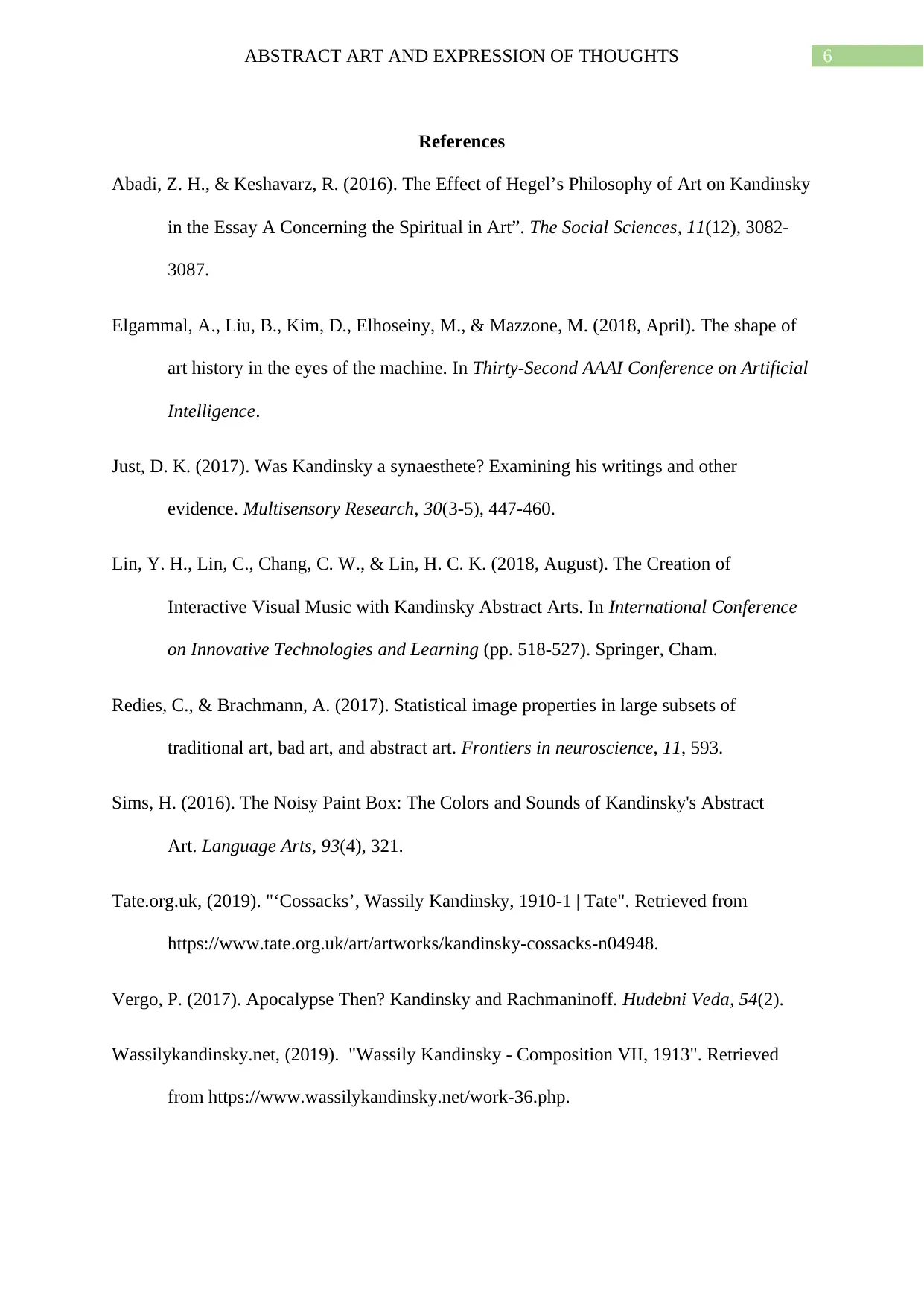
6ABSTRACT ART AND EXPRESSION OF THOUGHTS
References
Abadi, Z. H., & Keshavarz, R. (2016). The Effect of Hegel’s Philosophy of Art on Kandinsky
in the Essay A Concerning the Spiritual in Art”. The Social Sciences, 11(12), 3082-
3087.
Elgammal, A., Liu, B., Kim, D., Elhoseiny, M., & Mazzone, M. (2018, April). The shape of
art history in the eyes of the machine. In Thirty-Second AAAI Conference on Artificial
Intelligence.
Just, D. K. (2017). Was Kandinsky a synaesthete? Examining his writings and other
evidence. Multisensory Research, 30(3-5), 447-460.
Lin, Y. H., Lin, C., Chang, C. W., & Lin, H. C. K. (2018, August). The Creation of
Interactive Visual Music with Kandinsky Abstract Arts. In International Conference
on Innovative Technologies and Learning (pp. 518-527). Springer, Cham.
Redies, C., & Brachmann, A. (2017). Statistical image properties in large subsets of
traditional art, bad art, and abstract art. Frontiers in neuroscience, 11, 593.
Sims, H. (2016). The Noisy Paint Box: The Colors and Sounds of Kandinsky's Abstract
Art. Language Arts, 93(4), 321.
Tate.org.uk, (2019). "‘Cossacks’, Wassily Kandinsky, 1910-1 | Tate". Retrieved from
https://www.tate.org.uk/art/artworks/kandinsky-cossacks-n04948.
Vergo, P. (2017). Apocalypse Then? Kandinsky and Rachmaninoff. Hudebni Veda, 54(2).
Wassilykandinsky.net, (2019). "Wassily Kandinsky - Composition VII, 1913". Retrieved
from https://www.wassilykandinsky.net/work-36.php.
References
Abadi, Z. H., & Keshavarz, R. (2016). The Effect of Hegel’s Philosophy of Art on Kandinsky
in the Essay A Concerning the Spiritual in Art”. The Social Sciences, 11(12), 3082-
3087.
Elgammal, A., Liu, B., Kim, D., Elhoseiny, M., & Mazzone, M. (2018, April). The shape of
art history in the eyes of the machine. In Thirty-Second AAAI Conference on Artificial
Intelligence.
Just, D. K. (2017). Was Kandinsky a synaesthete? Examining his writings and other
evidence. Multisensory Research, 30(3-5), 447-460.
Lin, Y. H., Lin, C., Chang, C. W., & Lin, H. C. K. (2018, August). The Creation of
Interactive Visual Music with Kandinsky Abstract Arts. In International Conference
on Innovative Technologies and Learning (pp. 518-527). Springer, Cham.
Redies, C., & Brachmann, A. (2017). Statistical image properties in large subsets of
traditional art, bad art, and abstract art. Frontiers in neuroscience, 11, 593.
Sims, H. (2016). The Noisy Paint Box: The Colors and Sounds of Kandinsky's Abstract
Art. Language Arts, 93(4), 321.
Tate.org.uk, (2019). "‘Cossacks’, Wassily Kandinsky, 1910-1 | Tate". Retrieved from
https://www.tate.org.uk/art/artworks/kandinsky-cossacks-n04948.
Vergo, P. (2017). Apocalypse Then? Kandinsky and Rachmaninoff. Hudebni Veda, 54(2).
Wassilykandinsky.net, (2019). "Wassily Kandinsky - Composition VII, 1913". Retrieved
from https://www.wassilykandinsky.net/work-36.php.
Paraphrase This Document
Need a fresh take? Get an instant paraphrase of this document with our AI Paraphraser
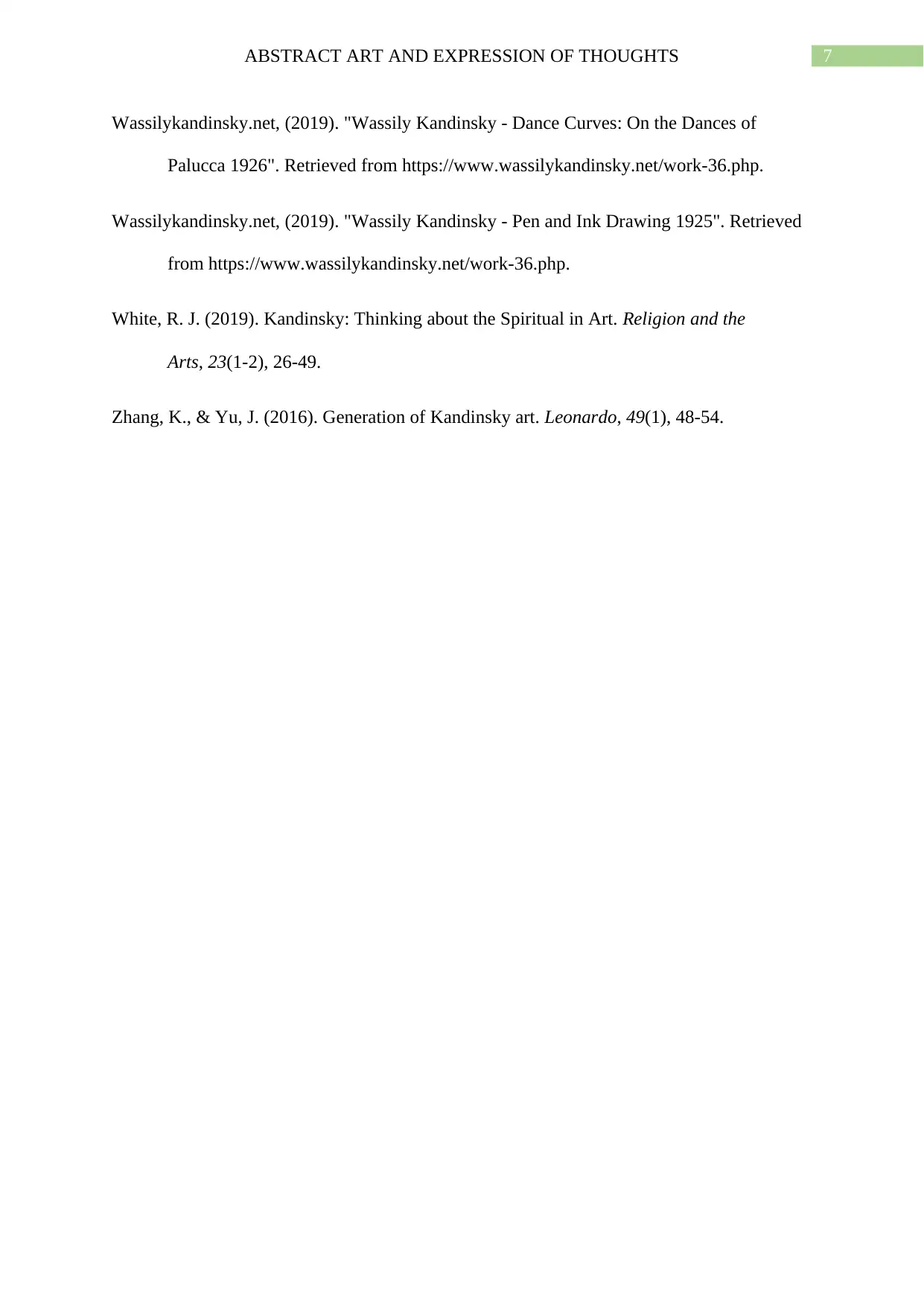
7ABSTRACT ART AND EXPRESSION OF THOUGHTS
Wassilykandinsky.net, (2019). "Wassily Kandinsky - Dance Curves: On the Dances of
Palucca 1926". Retrieved from https://www.wassilykandinsky.net/work-36.php.
Wassilykandinsky.net, (2019). "Wassily Kandinsky - Pen and Ink Drawing 1925". Retrieved
from https://www.wassilykandinsky.net/work-36.php.
White, R. J. (2019). Kandinsky: Thinking about the Spiritual in Art. Religion and the
Arts, 23(1-2), 26-49.
Zhang, K., & Yu, J. (2016). Generation of Kandinsky art. Leonardo, 49(1), 48-54.
Wassilykandinsky.net, (2019). "Wassily Kandinsky - Dance Curves: On the Dances of
Palucca 1926". Retrieved from https://www.wassilykandinsky.net/work-36.php.
Wassilykandinsky.net, (2019). "Wassily Kandinsky - Pen and Ink Drawing 1925". Retrieved
from https://www.wassilykandinsky.net/work-36.php.
White, R. J. (2019). Kandinsky: Thinking about the Spiritual in Art. Religion and the
Arts, 23(1-2), 26-49.
Zhang, K., & Yu, J. (2016). Generation of Kandinsky art. Leonardo, 49(1), 48-54.
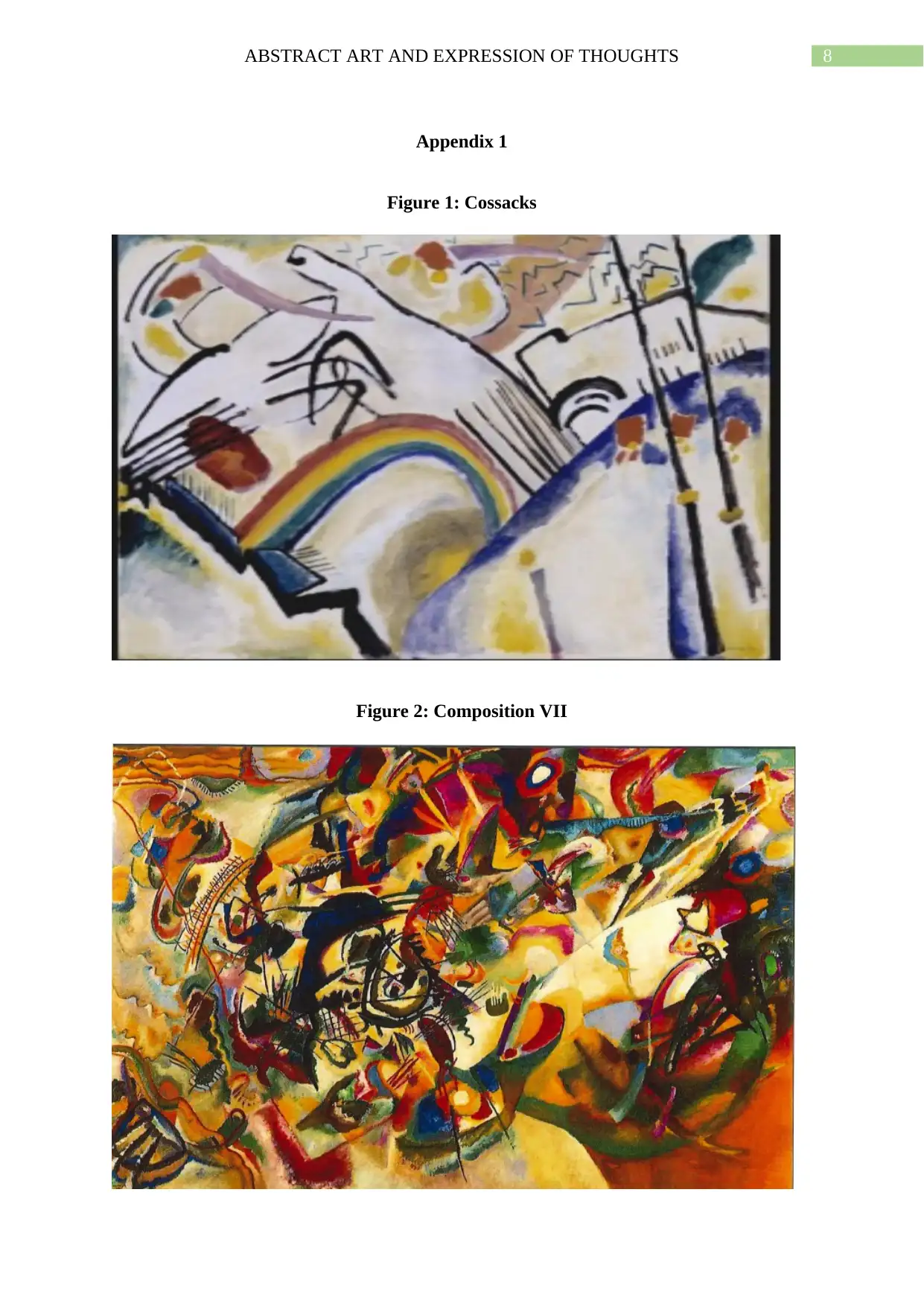
8ABSTRACT ART AND EXPRESSION OF THOUGHTS
Appendix 1
Figure 1: Cossacks
Figure 2: Composition VII
Appendix 1
Figure 1: Cossacks
Figure 2: Composition VII
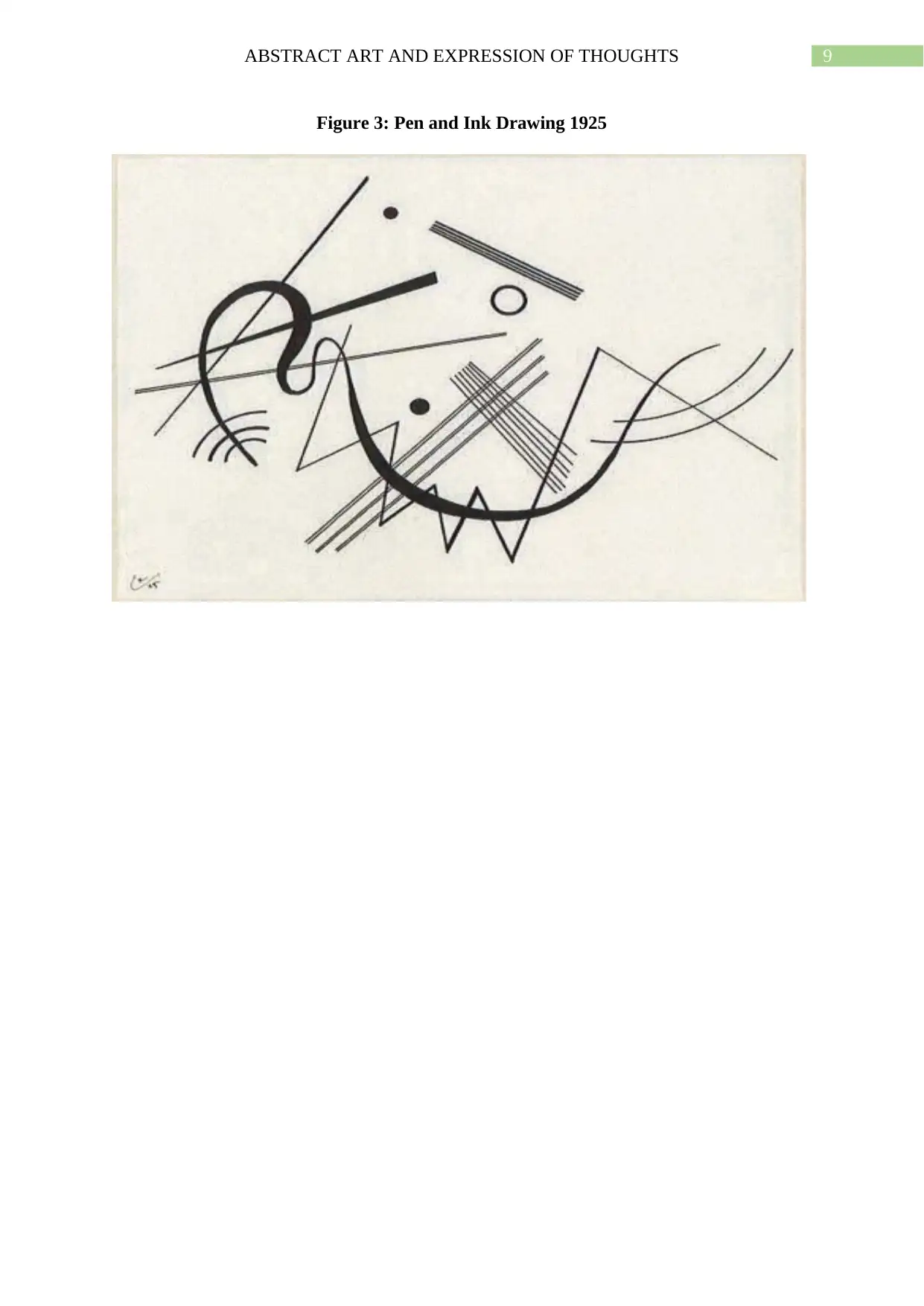
9ABSTRACT ART AND EXPRESSION OF THOUGHTS
Figure 3: Pen and Ink Drawing 1925
Figure 3: Pen and Ink Drawing 1925
Secure Best Marks with AI Grader
Need help grading? Try our AI Grader for instant feedback on your assignments.
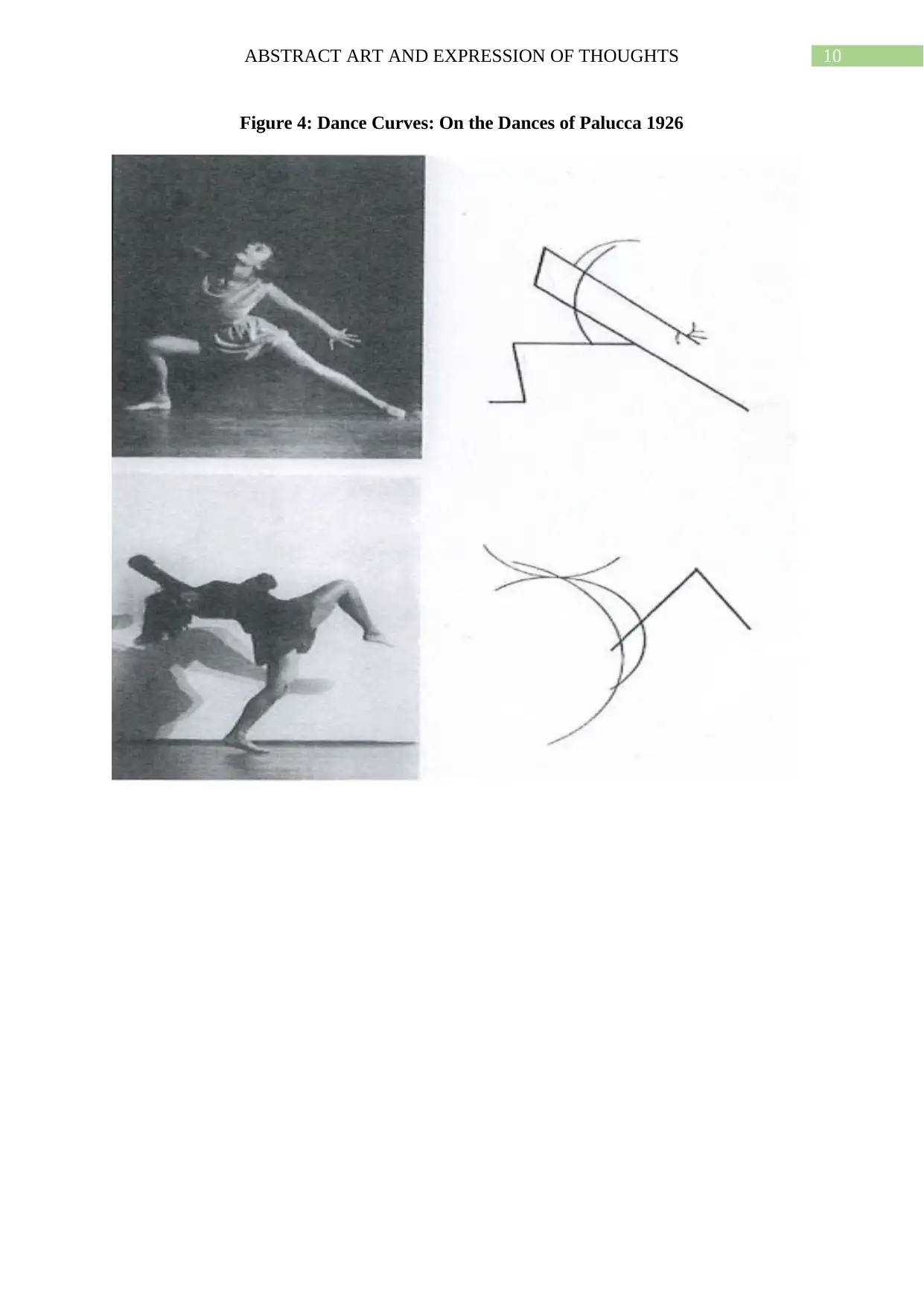
10ABSTRACT ART AND EXPRESSION OF THOUGHTS
Figure 4: Dance Curves: On the Dances of Palucca 1926
Figure 4: Dance Curves: On the Dances of Palucca 1926
1 out of 11
Related Documents
Your All-in-One AI-Powered Toolkit for Academic Success.
+13062052269
info@desklib.com
Available 24*7 on WhatsApp / Email
![[object Object]](/_next/static/media/star-bottom.7253800d.svg)
Unlock your academic potential
© 2024 | Zucol Services PVT LTD | All rights reserved.





